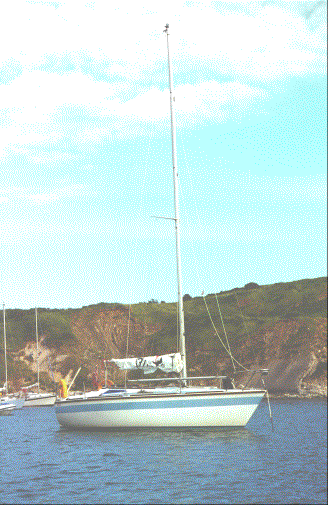

![[GK24 logo]](gk24logo.gif)

The review here is written from the viewpoint of either cruising or racing the boat two up, or rarely with more crew, mostly Round The Island (of Wight) races.
We have two children ( March 1998 and September 2000) and when we are sailing this means we have effectively 1.5 crew. One helming, the other rushing about.
It is definitely possible to hoist a spinnaker with 2 crew and recover it succesfully without the need for a snuffer. Short handed on Wednesday evenings racing it is often the case .
The boat is responsive to the helm, never being particularly heavy even when heeled, although there is some weather helm when beating. The rudder appears to be the same as some other 29 foot Westerlys with a transom hung rudder, as it is listed in spare part lists under the same heading, at about £1400 ! So repair rather than replacement seems to be the order of the day.
The helm tends to need fairly constant attention or an autopilot because the hull does not have a great deal of inherent directional stability, although it is possible to lash the helm for brief periods.
Off the wind it can become more of a handful, a beam reach with
spinnaker often resulting in holding the helm hard over to hold off the
broach. Letting the main out or the kicker off controls this.
More experience with the boat allows one to feel the beginnings of a
broach
and stop it. It seems less on the edge now at high speed. Having
a full crew when racing holds the boat more upright and in control.
A check on how close you are to hull speed is that the cockpit ends up at about sea level at high hull speed , with water just washing the Treadmaster if the boat is level. A tubby crew can make this worse !
I have never been out in more than a recorded 35 knots of wind, in
Southampton Water in the GK24, when reefed with 2 reefs in the main and
a 100% genoa. but others have
had to manage 50 knots off Brighton
and lived to tell the tale.
It is necessary to reef earlier than these other boats to turn down the power. In lighter airs, It is faster than many other cruising boats, even 30+ footers. You can literally sail in circles round Westerly Centaurs in a light breeze.
When you first step aboard, the boat heels quite noticeably, but then you are over 4 feet out from the centre line. Under sail, with main and No. 1 genoa the boat heels noticeably to the breeze but can easily hold full sail up to 15-18 knots apparent. With crew ballast the limit is higher. In an extreme case, I have feathered up in 30 knots of wind without the main flogging, in a sudden gust.
As this is more manageable we quite often use this configuration for
low-intensity sailing in stronger winds. We dont have to deal with the
mainsail trying to blow away We hoist a 100% jib/genoa and sail
slower, or motor-sail.
Recently we crossed from Hamble to Cowes in 27
knots SW wind average, 32 in the gusts with a 100% genoa up and
no main, and
still made to windward.
In this configuration, the boat will stop if the boat is first
feathered up into the wind to lose way and then the helm pushed down to
45 degrees
or so. The boat moves
very slowly to leeward and forward. Ideal for waiting
for shipping to pass in the Solent.
On another occasion we were lazy and sailed in 20-25 knots of wind with only the 135% genoa up.
We had started up off the wind but eventually we hardened up and we were still making to windward and overtaking other boats. As the wind gusted first there would be lee helm due to the off balance sail plan and then weather helm as the boat heeled. Once I got used to it it was OK but it took concentration. Putting up the main would have been easier.
The boat will point all over the place when rolled by the wash of a power boat, but if you hold the helm firmly it ends up mostly back on course, although a little worrying at the time.
Because the boat is not very long, the problem with progress is
rapid pitching in a choppy sea : the Solent is full of power boats and
tidal races that stop you dead in light winds. In heavier winds, crew
on
the rail make a huge difference. Out beyond the Needles the wave period
is longer and the boat begins to ride over the waves without stopping
or losing much way. Out there we can overtake boats that leave us
standing around the cans inside the Solent.
It is easy to stall the boat, even ending up going backwards after hitting a wake , so one has to free the sheets and bear away for speed before hardening up again. If you dont, the hull just makes leeway. In this respect it is like a performance sailing dinghy.
In waves, spray comes over the bows, but they usually lift over the waves (fast pitching!!), and so the occupants of the cockpit are showered rather than drenched.
On two other GK24s , the stainless steel straps holding the rudder
on
cracked and broke off in heavy seas. In one case the rudder
had been strained by contact with the sea bed. The boat had a
spare rudder on board. On the other boat the history was not known.
[top]